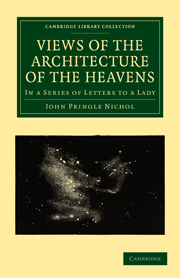Book contents
- Frontmatter
- Contents
- PLATES
- PART I THE FORM OF THE EXISTING UNIVERSE
- PART II THE CONSTITUENT MECHANISMS, OR THE PRINCIPLE OF THE VITALITY OF STELLAR ARRANGEMENTS
- LETTER IV Probable Universality of Planetary Systems—Relations of Stars to each other—Double Stars
- LETTER V Triple Stars—More Complex Relationships—Existence of Large Groups—Conjectures respecting Firmamental Systems
- PART III THE ORIGIN AND PROBABLE DESTINY OF THE PRESENT FORM OF THE MATERIAL CREATION
- NOTES
- Additions and Corrections
LETTER V - Triple Stars—More Complex Relationships—Existence of Large Groups—Conjectures respecting Firmamental Systems
Published online by Cambridge University Press: 29 August 2010
- Frontmatter
- Contents
- PLATES
- PART I THE FORM OF THE EXISTING UNIVERSE
- PART II THE CONSTITUENT MECHANISMS, OR THE PRINCIPLE OF THE VITALITY OF STELLAR ARRANGEMENTS
- LETTER IV Probable Universality of Planetary Systems—Relations of Stars to each other—Double Stars
- LETTER V Triple Stars—More Complex Relationships—Existence of Large Groups—Conjectures respecting Firmamental Systems
- PART III THE ORIGIN AND PROBABLE DESTINY OF THE PRESENT FORM OF THE MATERIAL CREATION
- NOTES
- Additions and Corrections
Summary
2. Guided by the Genius, whose prophetic eye pierced the obscurity, which, until then, had concealed the arrangements we have just unfolded—we advance cautiously, but without dread, to take cognizance of still higher schemes.—The arguments which induced Herschel to pronounce on the connexion and motion of the constituents of binary systems, penetrate much farther, and intimate as a general law, that every cluster or unusual aggregation of orbs must be systematic, and probably united by common motion. If it is unlikely that the principles of random scattering would produce numbers of double stars, it is plainly as unlikely that anytriple or quadruple bodies should be found in the whole sky ; and this holds even where the stars are more separated, as in the case of the six principal constituents of the Pleiades, against whose fortuitous aggregation within that space—as Michell long ago calculated—there is a balance of probabilities of 500,000 to 1. The presence of a great law thus lays it on astronomers as a command that they watch these higher systems, take their measurements with every minuteness, and transmit them to posterity. The results must be brilliant, and they are already foreshadowed. In a triple star in Cancer (ζ), we are certain of a common motion, in which three suns seem to revolve around a common central point; and in another—ψ CassiopeiÆ — one sun probably revolves around a second, while the two in union—a sun and an associated sun, circulate around the third.
- Type
- Chapter
- Information
- Views of the Architecture of the HeavensIn a Series of Letters to a Lady, pp. 98 - 114Publisher: Cambridge University PressPrint publication year: 2009First published in: 1837



